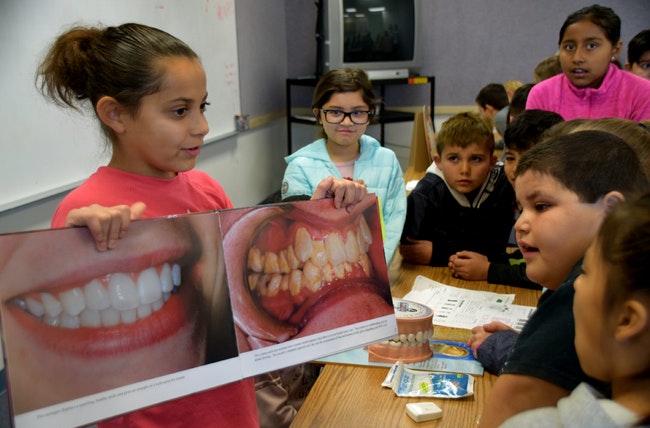 Fifth-grader Makiaha Daniel shows third-graders at Nyssa Elementary what happens if you don’t brush your teeth as part of Healthy, Happy Smiles, a grant-funded program that brings free dental services to eastern Oregon schools. (The Enterprise/Yadira Lopez)
Fifth-grader Makiaha Daniel shows third-graders at Nyssa Elementary what happens if you don’t brush your teeth as part of Healthy, Happy Smiles, a grant-funded program that brings free dental services to eastern Oregon schools. (The Enterprise/Yadira Lopez)
NYSSA – To a chorus of “eeewww,” fifth-grader Makiaha Daniel showed classmates at Nyssa Elementary School what can happen when you don’t brush your teeth.
Daniel’s prop: a book brought by Meghan Chancey, coordinator for Healthy, Happy Smiles, a school-based oral health program targeting eastern Oregon.
Since 2016, the grant-funded program has provided free dental services and oral health education to students in kindergarten through 12th grade in four counties: Harney, Grant, Baker and Malheur.
All four counties had higher-than-average rates of cavities among 6- to 9-year-olds, according to a 2012 survey. The Oregon Smile Survey reported that by that age, 73% of those children had already experienced a cavity, compared to the state average of 52%.
“You’ll get students who say ‘I don’t do that’ or ‘I only brush once a day and I’m fine’ or they’ll talk about how they think the dentist is scary, so we try to decrease that fear of going to the dentist’s office,” said Chancey.
Administered by the Eastern Oregon Healthy Living Alliance in partnership with Advantage Dental, the program allows Chancey to put on a hands-on dental learning lab at schools across the county.
[ KEEP YOUR LOCAL NEWS STRONG – SUBSCRIBE ]
The funding also pays for a dental hygienist to go into schools for free check-ups and dental services to students whose parents approve.
 Meghan Chancey, coordinator for Healthy, Happy Smiles, puts on hands-on dental labs at eastern Oregon schools to help educate kids about oral health. (The Enterprise/Yadira Lopez)
Meghan Chancey, coordinator for Healthy, Happy Smiles, puts on hands-on dental labs at eastern Oregon schools to help educate kids about oral health. (The Enterprise/Yadira Lopez)
“If a student is experiencing oral pain or an oral health-related illness, they are not only more likely to miss school, but they are most likely not learning to their full potential either,” said Jessica Steele, a dental hygienist who provides services through the program.
Roughly 51 million school hours are lost each year across the country due to a dental-related illness, studies show. Tooth decay, which can lead to cavities, is a leading cause of school absences, and one of the most common chronic childhood illnesses.
The services Steele provides through the program can help reduce that risk. Preventative services and early intervention provided through the Healthy, Happy Smiles program helped decrease the cavity rate in southeastern Oregon by 5% – more than double the program’s goal – according to a recent report.
Steele goes into schools with all the supplies she needs, including a portable dental chair. The visits don’t take the place of a dental appointment, Steele emphasized, but she provides services such as fluoride coating, varnish and dental sealants to help mitigate the likelihood of cavities.
“Hopefully long term they’re not going to the dentist as much for those pricey procedures. They’re just going for checkups,” Chancey said.
While the program serves over 5,000 students in 30 schools in the region, last year only 51% of students returned parent consent forms.
In Malheur County, parental consent was provided for only 26% of students last year, according to Chancey.
Chancey said she’s trying to boost that number. Program officials are trying incentives such as prizes to elementary students who turn them in, and gift cards to middle school students and their teachers.
“Probably a lot of kids who could use it are not taking advantage of it, certainly not everyone who could or we would have a lot more forms coming back,” said Mathew Murray, principal at Nyssa Elementary.
On a recent Thursday, Chancey had third graders in Rachelle Phillips’ class at Nyssa rotate through various stations.
At one, a fifth-grader helped split open a giant tooth to reveal plaque and other gunk. Meanwhile, Makiaha Daniels was in the corner flipping through the giant book with images of sparkly and not so sparkly whites.
At another table, students crowded around Chancey as she used a prop that looked like a giant tongue to show the effects of smoking on oral health. The pink, foam tongue had black marks on it. Chancey passed it around to anyone who wanted to touch it.
The response was – you guessed it – “eeewww.”
Have a news tip? Reporter Yadira Lopez: [email protected] or 541-473-3377
For the latest news, follow the Enterprise on Facebook and Twitter.
SUBSCRIBE TO HELP PRODUCE VITAL REPORTING — For $5 a month, you get breaking news alerts, emailed newsletters and around-the-clock access to our stories. We depend on subscribers to pay for in-depth, accurate news produced by a professional and highly trained staff. Help us grow and get better with your subscription. Sign up HERE.




